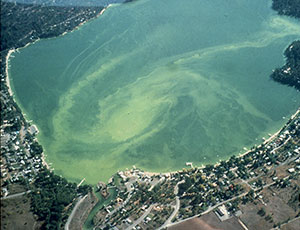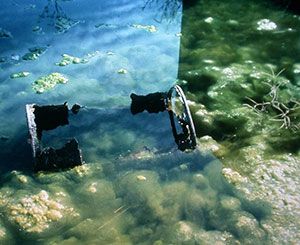By Craig Howard
Splash Contributor
In case you missed it, the Liberty Lake Sewer and Water District did observe its 40th anniversary earlier this year.
Like the district itself, the occasion on May 8 was understated, efficient and void of self-promotional window dressing. Billed as a low-key potluck with invitations to those who had served with the district over the years, the "official" celebration came and went with about as much hoopla as a routine test for alkalinity on the lake that bears the utility's name.
For district insiders like LLSWD Commissioner Tom Agnew, the idea of commemorating four decades with an extravagant agenda seemed slightly out of character.
"I'm not sure how excited the community would be about celebrating this anniversary," Agnew said. "After all, most of us take these things for granted. I think we've done a pretty good job if for no other reason than people expect the water and the wastewater systems to work and to the extent that they do, we just kind of become this part of the landscape."
Liberty Lake City Administrator Katy Allen is one district customer who feels LLSWD deserves kudos for its contributions to the community over the past 40 years. A resident of the area since 1983, Allen said the district warrants credit for "doing an outstanding job taking care of their infrastructure, keeping rates low and protecting the environment."
During her tenure with the city of Spokane Public Works department, Allen was part of a local utility network that included Mellish and current LLSWD Commissioner Steve Skipworth, who then worked at Spokane Valley-based Vera Water and Power. As a part of the Liberty Lake community, Allen said she appreciates district initiatives like the beach and leaf cleanup as well as water conservation efforts like the sensor system she had installed to monitor irrigation at her home.

Submitted photos
In these circa 1970s photos provided by the Liberty Lake Sewer and Water District, the invasive algae blooms that dominated the lake are seen from different vantage points. In 1968, five years before the LLSWD was officially formed, tons of decaying aquatic weeds and dried algal mats were being removed from the lake. Residents formed a citizens advisory committee and began sending water tests to Washington State University. It was the genesis of regular water quality testing of Liberty Lake by WSU that has continued to this day. Lake restoration efforts were under way.
 |
"I was sure thankful when I saw the difference in my water bill," Allen said.
Mark Richard, who served as a Spokane County commissioner from 2005 to 2012, said LLSWD is widely heralded for its efforts in environmental protection dating back to the campaign to save Liberty Lake that formed the groundwork for the district's formation.
"I think the district has shown great leadership and stewardship and certainly turned that lake around at a time when it was really going downhill," Richard said.
While plans for a ticker tape parade down Liberty Lake Road to honor LLSWD may not be in the works for this year, Agnew does acknowledge that a look back at the beginnings of the district and a basic grasp of its continuing mission is useful.
"We might not have a big party in the park, but there is some reason to raise the flag and remind people that it's a pretty robust history," he said. "There are some really key people who made it happen. Besides that, it's more of a reflection of what our community has done than the commissioners or the staff. The district has the support of the community and that makes it easier to do our jobs. I think the community deserves the bulk of the credit."
The Roots
Etienne Eduard Laliberte homesteaded on the west side of Liberty Lake in the 1870s, but that once-pristine watershed had become a distant memory nearly a century later. Murky, blue-green currents characterized Liberty Lake by the late 1960s as invasive algae blooms began to monopolize the surface. Meanwhile, tons of deteriorating plants and algae were being removed from the lake each year.
"You'd drive a boat across the lake and you'd see a path," said Harley Halverson, who served as LLSWD commissioner from 1992 to 2007.
Over time, the algae buildup became so thick and toxic that plants below the surface couldn't photosynthesize. Meanwhile, as plants died and decayed, oxygen for fish was steadily depleting. Visitors to the lake began to see posted signs that warned against public use.
"I can't remember exactly what the signs said, but the lake was noticeably uninviting," Agnew said.
When it came to water recreation, most people in the area made it a point to avoid Liberty Lake because of its new status as a swampy quagmire. For a group of residents living around the lake, however, the bleak scenario became a rallying point.
A citizens advisory committee was formed in 1968, and soon after, samples from the lake were sent to Washington State University for testing. Later, the committee, led by Denny Ashlock, petitioned Spokane County commissioners to form a sewer district to address the scourge of effluent from septic tanks surrounding the lake.
"You have to kind of get in perspective that when we started all this, there wasn't a city here," Halverson said. "There was the lake and the people around the lake - and for the people around the lake, their focus was the lake. There wasn't a sewer district, there wasn't a city. Every decision was made in regard to the lake."
In 1973, the Liberty Lake Sewer District (the Water part would be added later) was formed with residents voting in the first trio of commissioners -Ashlock, Skip Toreson and Bill Lancaster.
"I was approached by one of the old-time residents of the lake to run as a write-in prior to the election," said Toreson, who served on the board from 1973 to 1989. "I had been interested in the lake's water quality since we moved back in 1970. I thought it would be a good thing to be involved and work to help."
The commissioners
Following is a list of the men and women who have led the Liberty Lake Sewer and Water District on the board of commissioners.
Denny Ashlock - June 1973 to September 1981
Art "Skip" Toreson - June 1973 to December 1989
Bill Lancaster - June 1973 to December 1975
Shirley Johnson - December 1975 to September 1976
Lynn Genteman - September 1976 to December 1977
Rick Manum - December 1977 to November 1988
Gib Sears - September 1981 to December 1991
Cris Hayes - December 1988 to December 1989
Bill Hemmings - January 1990 to February 1992
Jack Blair - January 1990 to December 1993
Frank L. Boyle - January 1992 to September 2012
Harley Halverson - October 1992 to February 2007
Bob Gamble - January 1994 to December 1999
Tom Agnew - January 2000 to present
Steve Skipworth - February 2007 to present
Kottayam V. Natarajan Jr. - December 2012 to present

Splash photo by Craig Howard
From left, BiJay Adams, Harley Halverson, Lee Mellish and Tom Agnew catch up during the Liberty Lake Sewer and Water District's 40th anniversary year. Adams recently replaced Mellish as general manager, and Halverson and Agnew are both longtime commissioners.
"The Rebirth of Liberty Lake"
When Liberty Lake was the putrid eye
of a fish left on the beach to rot,
the common sewer
of a hundred years of human neglect,
the lake lovers would not concede
her to the mud, the snakes,
bullfrogs and bloodsuckers.
They saw the black, unruly hair
that clogged the underground streams
and stilled the motion of propellers,
the mud that advanced upon the water,
the algae that bloomed upon the vacated beaches,
but they would not leave.
They found an antidote
and poured it into the wound
cut back the long, unruly hair
and opened the clogged veins
of the virgin, underground streams.
All morning I watch
the grebes dip their whole bodies into the lake
and bob back up again.
I look at the face of the lake
that the wind impresses with gusty rhythms
that the light dresses and undresses
in green silk, azure and silver sheen
an ever changing impressionist painting
and thank the lake lovers
who saw the mud,
but would not turn away.
- Poem by Eleanor Limmer, Liberty Lake
|
The Restoration
WSU continued to conduct research of lake samples and, in 1974, collaborated with the district to publish a comprehensive water quality study that included possible treatment strategies. A year later, LLSWD received a grant through the Clean Lakes program to build a sewage collection and treatment system.
Sue Kaun moved with her husband and three kids to the Liberty Lake area in 1974 and soon became part of the local effort to save the lake. She began working for the district as a part-time clerk and eventually rose to the rank of general manager. Kaun would be part of the staff from 1976 to 1990, a critical time that saw LLSWD establish itself as a civic bellwether and one of the region's most respected special purpose districts.
"I am most proud of the fact that with the assistance of state and federal agencies, a small community carried out a vision to successfully restore, protect and preserve Liberty Lake, and importantly, the work continues today," Kaun said.
Kaun was there when the design of the sewage collection system began in 1976. Construction began a year later, with residences being connected to the lines once they were ready. As septic tank pollution subsided, the condition of the lake began to improve. In 1980, the district oversaw the dredging of 50 acres on the southwest end of the lake that eliminated a two-foot layer of sludge.
"I remember standing on the dock with my neighbor, and he says, ‘No way this little community can afford or needs a sewer district,'" Agnew said. "The next year, we're standing on the dock, and he says, ‘This lake hasn't been this clear ever, and I've lived here 25 years!'"
Kaun now lives on the west side of the state and says she has even greater appreciation for the strides made by the district in those early years.
"After observing how difficult it has been for the city of Bellingham and Whatcom County to seriously address the water quality decline in Lake Whatcom, which is listed as an impaired lake by the Department of Ecology, I began to realize how rare and difficult it is to save a lake," she said.
By 1982, the district announced the completion of its wastewater treatment plant. Within two years, the floor of the lake was visible for the first time in decades.
"It was like night and day," Agnew said. "Sanitary sewers have improved the quality of water. Now I think there's emerging sense that we're the reason there's as little pollution as there is."
The Repercussions
While state-of-the-art systems for sewer collection and treatment were online in Liberty Lake by the early 1980s, the economy - and corresponding development - were far from flourishing. The area's main employer, Hewlett Packard, which was expected to build up to as many as 10,000 employees, peaked at 1,700. LLSWD officials found themselves trying to maintain a new plant processing far short of the available capacity.
"We ended up with a much larger sewer system and therefore the operations and expenses incurred with that," Agnew said. "The system was bigger than necessary, and the ratepayer base could not support it."
When Mellish arrived as the new general manager in March of 1993, he learned that the district had scarcely enough funds to cover payroll the month before.
"The economy in 1993 still hadn't recovered, but fairly soon after that, things really started picking up," Mellish recalled. "The success here wasn't because of me, it was the economy. You had all these developments out here, everything north of the lake like Meadowwood and others. It was pretty much one developer, Greenstone and Jim Frank."
When construction took off, the district was ready. For more than a decade, the infrastructure had been in place to manage the collection and treatment of up to 1 million gallons of wastewater per day.
"The revenue comes from the customer," Mellish said. "If you don't have new customers, the only way you can keep up with inflation is to raise the rates. It was just real stagnant, but things really started taking off after 1993. We were getting 125, 130 houses a year."
The Reputation
In 1988, just six years after opening the treatment plant, LLSWD was acknowledged by the Environmental Protection Agency with a Superior Service award "in recognition of outstanding leadership in lake restoration, protection of groundwater supplies and Spokane River water quality improvement."
Over the years, the district has collected enough honors to fill a pair of trophy cases. Along with the "Outstanding Performance Award" from the Washington state Department of Ecology in 1997, 2006, 2008, 2009 and 2010, LLSWD was named "District of the Year" by the Washington Association of Sewer and Water Districts in 2002.
Along with the accolades, the district has set the standard in passing ordinances that protect watersheds from products that contain phosphorous, a nutrient-rich substance that promotes growth of aquatic plants. When plants die, the decomposition robs the water of oxygen, leading to the demise of fish species. LLSWD was the first district in the nation to pass a resolution against both phosphorous laundry detergent and dishwashing soap, and the first in Washington state to ban fertilizers with phosphorous.
"We've been looked at as the people to go to," said current LLSWD General Manager BiJay Adams, who began as the district's lake protection manager in 2002. "We get calls from people all over the country about lake management and what we've done here. We really kind of set the precedent not only on the lake management side but also on the utility and sewer and water side of things."
Jeremy Jenkins, the new lake protection manager, oversees water resource education and conservation efforts for the district as well as stormwater management and water quality monitoring. Leading by example, the district has employed xeriscaping - a method of landscaping with a lower premium on irrigation - at its headquarters on Mission Avenue.
When the district completed an ambitious upgrade to its treatment plant in 2006, there was no need to put a bond on a ballot for the project. The district paid for the expansion with its own money and help from the public works trust fund.
"We had $7 million we'd saved for the plant upgrade," Mellish said.
The upgrade expanded the capacity of the plant to two million gallons a day.
"We are a nonprofit," Adams said "The money we save is not to buy fancy stuff; it's for capital improvement projects."
Despite the challenges of maintaining and building efficient and up-to-date infrastructure, the district has managed to keep water and sewer rates among the lowest in the state. Water charges have remained unchanged for 20 years while commissioners approved a rare hike in sewer rates (8.5 percent) at the end of 2012.
"One of the things we've always prided ourselves in here is customer service, whether it's the beach and leaf cleanup, the phosphorous-free fertilizer giveaway or whatever," Mellish said. "It's just the way things have always been around here."
From grappling with the Department of Fish and Game over the application of Rotenone - a poisonous substance used to eliminate certain types of fish prior to the lake being replenished with a stock more appealing to the fishing crowd - to successfully refuting the city of Liberty Lake's bid to add the utility business to its municipal portfolio during an expensive and lawsuit-ridden assumption attempt, the district has scaled some daunting hurdles over the years. In nearly every case, the late Frank L. Boyle was front and center. The longtime commissioner passed away last fall while in office. He had served the district faithfully since 1992.
"I remember saying if Frank Boyle ever resigns from this thing, I'm gone," Halverson said. "He had such a good memory for the past. Whenever we would make a decision, he would know the history and that was very, very helpful."
Kottayam V. Natarajan Jr. was appointed to replace Boyle last December, joining Agnew and Skipworth to form the district's latest board triumvirate.
District old-timers like Mellish will tell you that it has not always been smooth sailing for an organization that is now viewed as a standard-bearer for special purpose districts. The first go-around of the beach and leaf cleanup - an event that one year netted more than 9,000 bags - residents simply raked their refuse into the front yard. District officials were left with the painstaking task of transferring the piles into a front-end loader then into a dump truck.
"It was a bad day," Mellish said. "We learned a lot."
Moving forward, the district will face its share of challenges, including a mandatory upgrade of the treatment plant due by 2018 with an estimated pricetag of $12.8 million. Yet Adams and others who now constitute the LLSWD leadership crew say they will navigate the waters with an appreciation of the district's unique history, as well as an eye toward the future.
"When I got here, I really made it a point to educate myself about the district and the history," Adams said. "It definitely meant a lot to do my own research, but it also really helped to do talk to the individuals who were around. I learned a lot by talking to people like Lee and Harley and certainly Frank. These people are the history. It's one of the best examples of grassroots efforts you'll ever find. What the district is doing now is just giving back to the community."






